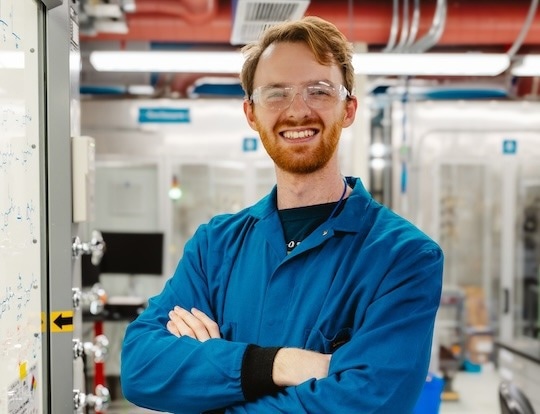Catalysts play a crucial role in accelerating chemical reactions, making them more efficient. Developing new catalytic technologies is essential for advancing the green energy transition.
 Aaron Bayles is a Rice University doctoral alum, a postdoctoral researcher at the National Renewable Energy Laboratory, and a lead author on a paper published in the Proceedings of the National Academy of Sciences. Image Credit: Aaron Bayles/Rice University.
Aaron Bayles is a Rice University doctoral alum, a postdoctoral researcher at the National Renewable Energy Laboratory, and a lead author on a paper published in the Proceedings of the National Academy of Sciences. Image Credit: Aaron Bayles/Rice University.
Naomi Halas’ lab of nanotechnology at Rice University has discovered an innovative method to enhance the catalytic capabilities of aluminum nanoparticles. This was achieved by annealing the nanoparticles in different gas atmospheres to elevated temperatures.
In a study reported in the Proceedings of the National Academy of Sciences, scientists from Rice University and their collaborators demonstrated that altering the structure of the oxide layer surrounding the particles can change their catalytic behavior. The findings make aluminum nanoparticles a versatile tool that can be customized for various applications, from producing sustainable fuels to facilitating water-based reactions.
Aluminum is an earth-abundant metal used in many structural and technological applications. All aluminum is coated with a surface oxide, and until now we did not know what the structure of this native oxide layer on the nanoparticles was. This has been a limiting factor preventing the widespread application of aluminum nanoparticles.
Aaron Bayles, Study Lead Author and Doctoral Alum, Rice University
Aluminum nanoparticles exhibit exceptional light absorption and scattering capabilities, primarily attributed to surface plasmon resonance. This phenomenon refers to the synchronized oscillation of electrons on the metal's surface when exposed to particular wavelengths of light. Similar to other plasmonic nanoparticles, the aluminum nanocrystal core acts as a nanoscale optical antenna, making it an attractive catalyst for light-driven reactions.
Bayles added, “Almost every chemical, every plastic that we use on a day-to-day basis, came from a catalytic process, and many of these catalytic processes rely on precious metals like platinum, rhodium, ruthenium, and others.”
“Our ultimate goal is to revolutionize catalysis, making it more accessible, efficient, and environmentally friendly,” stated Halas, who holds the title of University Professor, which is the highest academic rank at Rice.
He further added,“By harnessing the potential of plasmonic photocatalysis, we’re paving the way for a brighter, more sustainable future.”
The Halas team has focused on advancing aluminum nanoparticles for plasmonic photocatalysis applications, including the decomposition of risky chemical warfare agents and the efficient fabrication of commodity chemicals. The recently discovered capacity to alter the oxides on the surface of aluminum nanoparticles expands their potential use as effective catalysts for the chemical energy conversion of light.
“If you are doing a catalytic reaction, the molecules of the substance you’re looking to transform will interact with the aluminum oxide layer rather than with the aluminum metal core, but that metallic nanocrystal core is uniquely able to absorb light very efficiently and convert it into energy, while the oxide layer fulfills the role of a reactor, transferring that energy to reactant molecules.” Bayler added.
The characteristics of the oxide coating on nanoparticles play a crucial role in their interactions with other molecules or materials. This study investigates the structure of the natural oxide layer on aluminum nanoparticles and demonstrates that basic thermal treatments, such as heating the particles to temperatures up to 500 °Celsius (932 °Fahrenheit) in various gases, can alter this structure.
Bayles added, “The crystalline phase, intraparticle strain, and defect density can all be modified by this straightforward approach. Initially, I was convinced that the thermal treatments did nothing, but the results surprised me.”
One of the outcomes of the thermal treatments was to render the aluminum nanoparticles better at enabling the conversion of carbon dioxide into water and carbon monoxide.
“Changing the alumina layer in this manner affects its catalytic properties, particularly for light-driven carbon dioxide reduction, which means the nanoparticles could be useful for producing sustainable fuels,” added Bayles, who is currently a postdoctoral researcher at the National Renewable Energy Laboratory.
He added that the ability “to use abundant aluminum in place of precious metals could be hugely impactful to combat climate change and opens the way for other materials to be similarly enhanced.”
“It was relatively easy to do these treatments and get big changes in catalytic behavior, which is surprising because aluminum oxide is famously not reactive—it is very stable,” Bayles explained. “So for something that is a little bit more reactive—like titanium oxide or copper oxide—you might see even bigger effects.”
The study was supported by the Defense Threat Reduction Agency (HDTRA1-16-1-0042), the Air Force Office of Scientific Research (FA9550-15-1-0022), the National Science Foundation (1449500, 1905757, 2239545), the Department of Defense SMART Scholarship, the Robert A. Welch Foundation (C-1220, C-1222, C-2065), and Fulbright Colombia-Pasaporte a la Ciencia.
Journal Reference:
Bayles, A., et al. (2024) Tailoring the Aluminum nanocrystal surface oxide for all-Aluminum-based antenna-reactor plasmonic photocatalysts. Proceedings of the National Academy of Sciences. doi: 10.1073/pnas.2321852121.